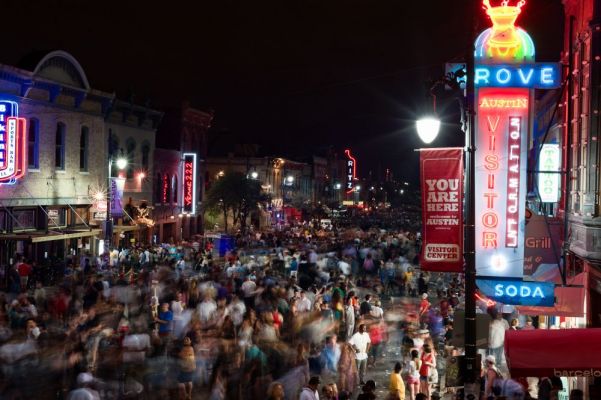Home > News
06/09/2016
Austin: Lessons for Portland?
By MELLISH // Bursting at the Seams – The Condition and Dreams of the Country’s Coolest Cities. What can Portland learn?
If you live in a city where 1,000 people stream in every month to quench the thirst for good music, food, craft beer, eclectic people, and creative atmosphere, when would the bubble burst? When would the community who built it up get priced out, and then where would it start all over again?
The number 1,000 rang true one year ago when I hit the nexus of the South by Southwest Music Festival in Austin, Texas. Back from 10 days immersed in the Live Music Capital of the World’s fabled stage, I learned from a UT Professor of Planning that the number of people a month moving there today … now numbers 5,000. Word out on the street is that less than half of the bands that play in the city are from there anymore, melting away like the West Antarctic Ice Sheet.
In my time there, Austin featured three festivals: The Honk!TX Festival – A free gathering of Community Street Bands that played New Orleans second-line brass, European Klezmer, Balkan, Brazilian, and West African from other lands; After an interval, the Fusebox Festival – A collision of performance, film, music, visual art, culinary, social event, public art project, and everything in between (100% free); and then a vision wrapped around the mind like Christo in the words of the electronic dance music Euphoria Festival, a proponent … of the following manifesto: “We belong here, in this place, which is far more than a music venue; far more than a festival, it's a completely immersive experience, a place where you listen, create, feel and literally — live in the moment.”
It’s not hard to see why so many people move here.
One feature of my host and long-time resident Bon’s place embodies what’s slipping away amid the creative decay and incredible building boom phase, with his … Day Clock – a clock on the wall that instead of hours has days. Most of us work to get out of the 9-5 mindset, but when you’re already out and nocturnal, the Day Clock is always in, tied by an umbilical chord to the diurnal.
Austin has its version of streets like Beale and Bourbon, AKA 6th Street, but away from the downtown tourists and middle class, beyond the Interstate 35 overpass lies an area less urban in East Austin left of the dial with more welcoming venues and style. Formerly, one of the no-go zones – and isn’t that always the way, today it’s a destination for shows.
But even downtown still features the subterranean Elephant Room’s basement shade, where I caught Texas native tenor saxophonist Tomás Ramírez, the Jazzmanian Devil, playing his fifth decade.
Nearby stood a speakeasy known as the Firehouse, where the small exterior stood deceptively quiet with the night behind it, until one passed through a sliding bookcase, into a dark, red walled intimate space with reclaimed wood bar, artwork on exposed brick walls to see, and a small stage, where a 3 piece set up leisurely. Bon guided us here for a warm-up drink that lent itself to the night and week’s main event.
)We strode diagonally across the street to the Contemporary Austin, an artist’s utopia that featured an art exhibit called Myopia. Mark Mothersbaugh, the artist better known for the Wes Anderson soundtracks he scored, and even better known as the former lead singer of Devo, presented the show of the Fusebox Festival on a 6-sided keyboard.
Actually, he composed music for 6 musicians to play on every side of the keyboard, seated together, men and women of different stripes -- all wearing jumpsuits of solid white. With numbers on them. Standing triumphantly on the rooftop stage of the art museum featured Mothersbaugh, wearing a striped referee shirt, with a whistle blown to start each composition, after which he triumphantly raised his arms in a touchdown position. The video screen above and behind the keyboard displayed all sixty fingers so the audience could see what each musician played.
He wrote all material in between Wes Anderson films and what was described as day work, something absurd like Pee Wee’s Playhouse – his first of many shows on TV, and a piece for the Simpsons video game with the sound of strings when Homer runs through the food court grabbing things.
Intricately layered bleeps, bloops, and syncopations built up and out of cacophony somehow came together off of six musical charts, and created angular melody with titles like "Well Intentioned Misinformation from the Heart."
Mothersbaugh announced “This next piece answers the question ‘Where Does Our Food Come From?’”
One musician threw some sheet music into the air overhead and behind the keyboard at the end of the piece that couldn’t be sung. Others followed and released theirs onto the astroturf below. Mothersbaugh, who didn’t actually play, made a paper airplane out of one, when he wasn’t fiddling knobs on equipment surrounding the keyboard during the show.
The 10:30 pm performance vibrated the rooftop to the point where the video screen shook. A very expensive apartment building that overlooked the rooftop evidently housed blueblood Austinites who put up a vociferous fight rather than stay mum, and showed the change occurring in cities can upset the historic balance on all sides of the spectrum.
Mothersbaugh stayed true to his Akron, OH Midwest background after the show by not playing the star and hanging around. I picked up “Where Does Our Food Come From?” sheet music designed for keyboard #1 that laid on the ground, and handed another one to Bon so we could get them signed.
When my turn came I asked the obvious question – “What was the strangest request you ever had to whip?” Stammering, he asserted the famous song wasn’t about sex.
“Whip It” song lyric excerpt:
When a problem comes along
You must whip it
Before the cream sets out too long
You must whip it
While I didn’t say the question was about sex, his assertion ran counter to my mnemonic reflex of the popular S&M tinged 1980 video clip. Somehow the connection discussed gave his past a slip, and he actually sat down on the lip of the stage nonplussed. At that point I thanked him for a great show. Then on the way out Bon and I marveled at Mothersbaugh’s clever art exhibit downstairs of unique creations of two cars and another of two mares with no front but two backs fused seamlessly faced together. And Pop Cubist work that broke through the eye’s maps, futuristic sketches on graph paper, and early Devo band pictures of matching round energy dome hats, and disturbing baby masks.
Bon suggested that our anti-hero probably wanted to talk about the evening’s compositions, rather than his old New Wave benediction. Understood, but his present will always fit what his future obit will read: “Lead Singer of the Band Behind ‘Whip It.’”
When some of our greatest artists have been expiring like overdue library books, it was an honor to get an up-close look at a courageous visionary, who has made a living out of creating offbeat, original universes that are nothing short of evolutionary.








